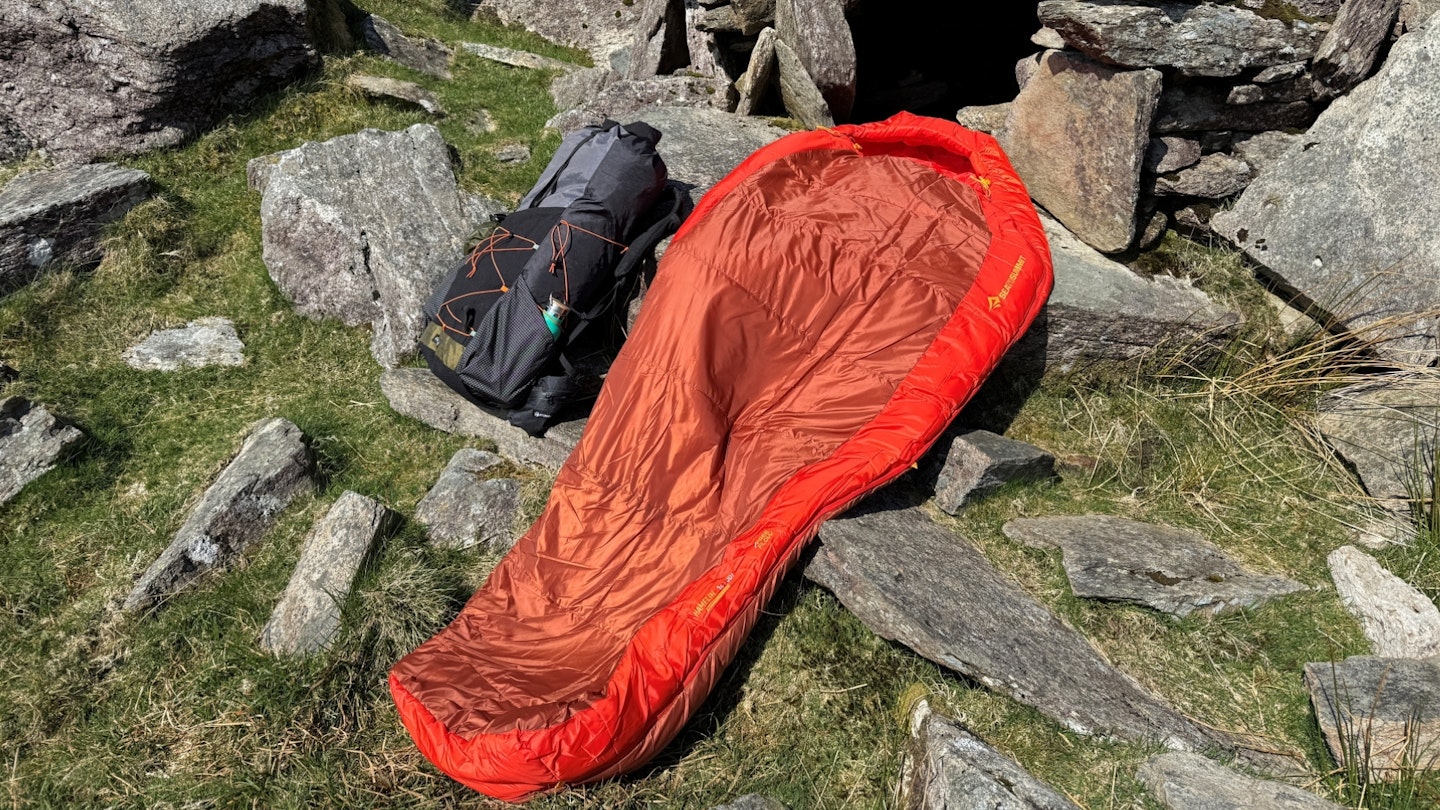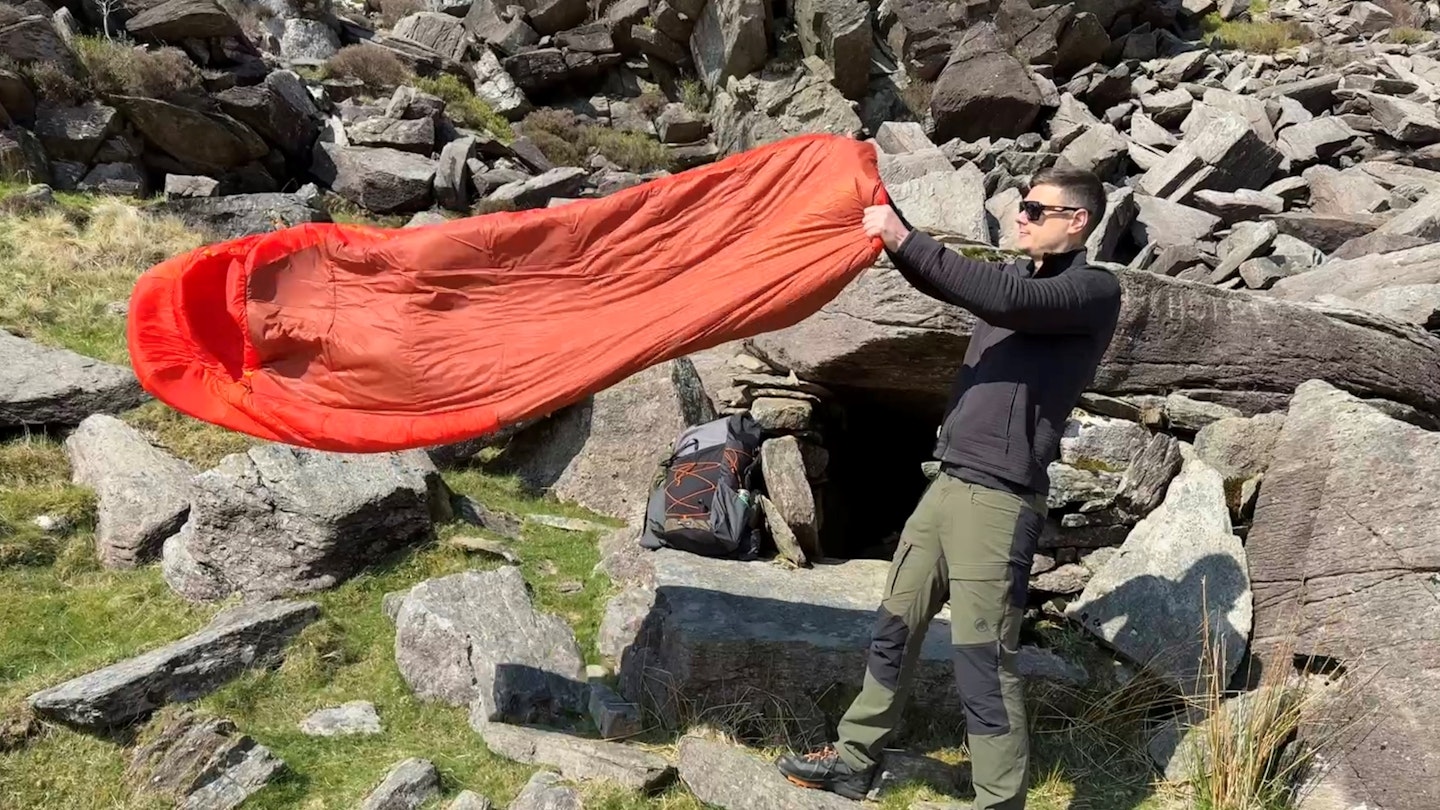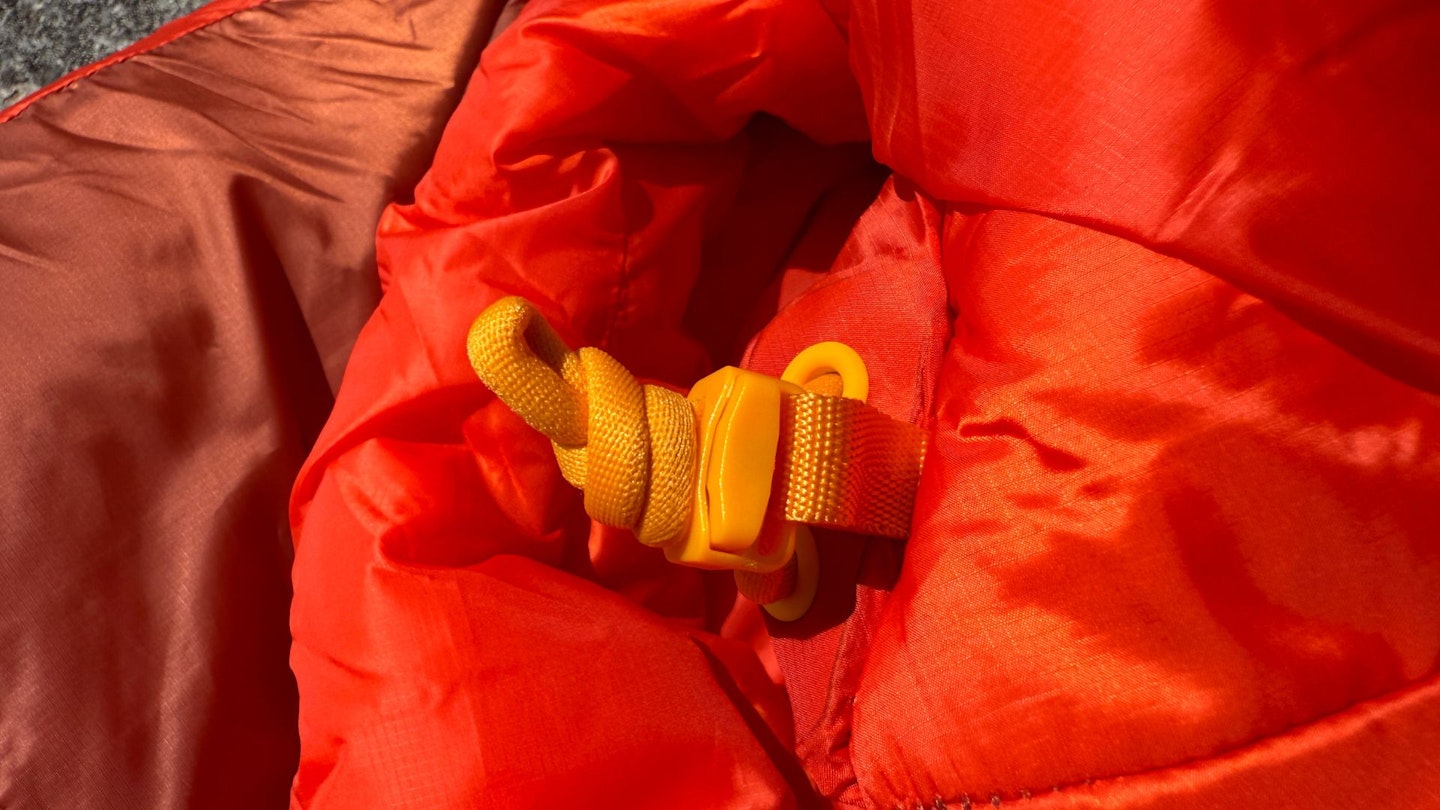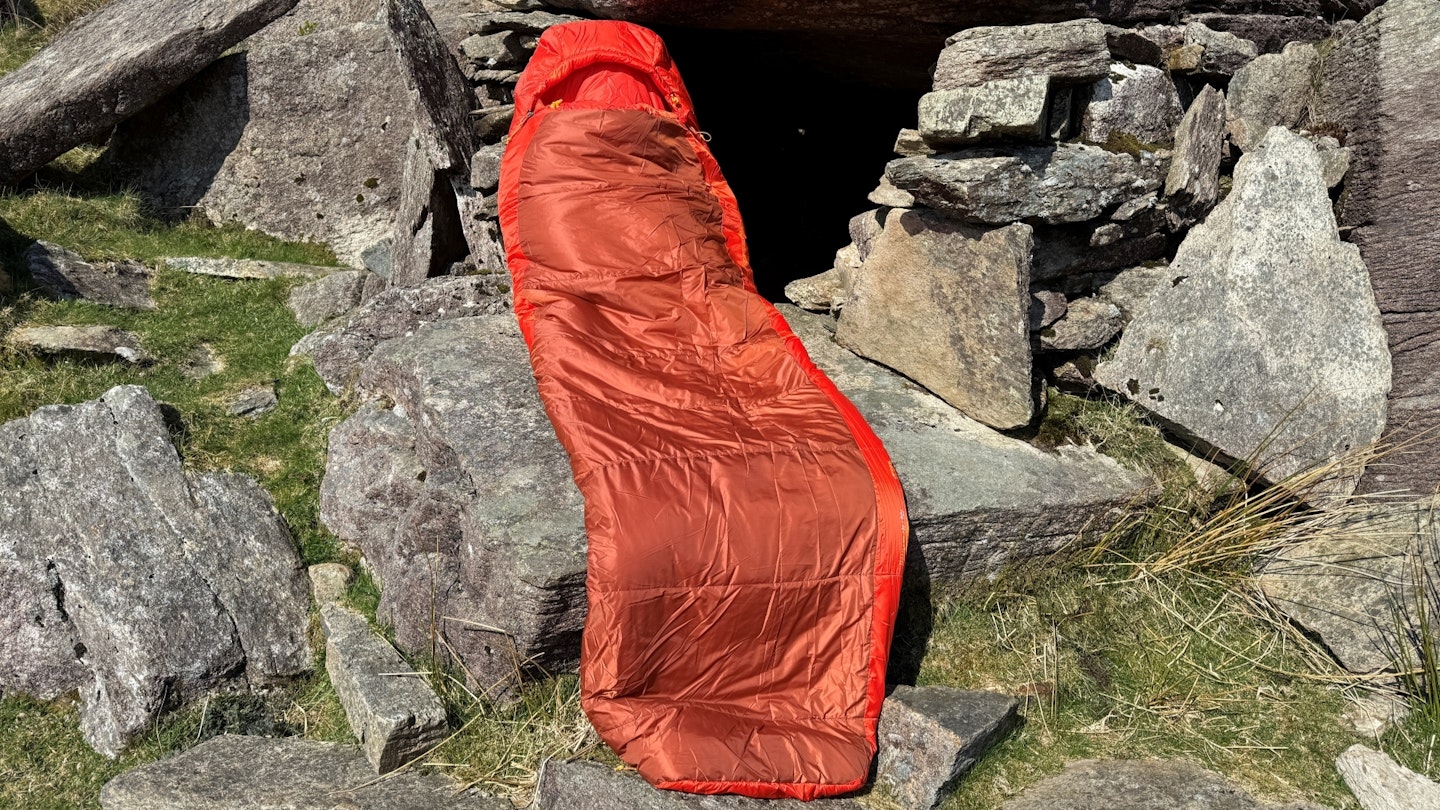The Sea to Summit Hamelin Synthetic -1C is a well-rounded synthetic sleeping bag ideal for spring and summer wild camping and bivvying, especially in the UK’s damp climate. Priced at £170 ($169), it offers excellent value, with standout eco credentials.
For backpackers and wild campers whose priorities when it comes to kit are minimal bulk and weight, a down-filled sleeping bag makes way more sense than a synthetic option. After all, high-grade down is the undisputed champion of insulation when it comes to overall warmth for weight.
However, there are many reasons why you might opt for a synthetic bag. The first is cost. Premium down is expensive, and synthetic bags are considerably cheaper, making them a good choice for backpackers on a budget.
Secondly there are questions of ethics. Natural down is sourced from ducks and geese, usually as a byproduct of the meat industry. This means that down gear is obviously not vegan-friendly, which is a barrier for some outdoor enthusiasts.
Even non-vegans may have qualms about the sourcing of down – historically it has been associated with dubious practices such as live-plucking, force feeding and bill-trimming. All reputable outdoor brands now use responsibly sourced down, but some schemes and certifications are more robust than others, and without full supply chain transparency they can still be open to abuse from unscrupulous suppliers.
Ultimately, the use of recycled fibres such as polyester in both sleeping bag fabrics and fills can make synthetic a better choice from an environmental standpoint.
Third are practical considerations, which are particularly important here in the UK. Synthetic fill is hard-wearing, easier to maintain and quicker drying than down. It also offers superior performance in damp conditions. If you spend a lot of time battling with condensation in your tent, bivvying out in the open or camping in wet weather, then synthetic sleeping bags start to make a lot more sense.
Check out the women's version
Pros
- Good value for a synthetic bag
- Solid eco credentials
- Comfort-focused design
- Excellent ventilation via full and half zips
- Performs well in damp weather
- Easier to care for than down
Cons
- Heavier and bulkier than down equivalents
- Not the warmest
| RRP: | £170/$169 |
| Sizes: | Men’s regular (to fit up to 185cm) and long (up to 198cm), women’s regular (up to 170cm) and long (up to 185cm) |
| Packed size: | 41x28x18cm (men’s reg and long), 29x25x17cm (women’s reg), 47x30x20cm (women’s long) |
| Weight: | 1124g/2.5lb(men’s reg), 1263g/2.8lb (men’s long), 1447g/3.2lb (women’s reg), 1645g/3.6oz (women’s long) |
| Insulation: | 100% RCS-certified, post-consumer recycled, multi-denier synthetic insulation |
| Materials: | Bluesign APPROVED, 20D recycled polyester shell with non-PFC DWR. 20D Bluesign APPROVED recycled polyester liner |
| Temperature rating: | Comfort 3°C | Lower limit -1°C (men’s), Comfort -1°C (women’s) |
While synthetic insulation doesn’t match down’s warmth-to-weight ratio, the Sea to Summit Hamelin -1C sleeping bag performs better in wet conditions, dries faster and is easier to care for – making it a practical and arguably more ethical alternative.
The Hamelin’s comfort-focused design includes a relaxed mummy shape, gender-specific fits and regular or long lengths.
Clever features such as an extended full-length zip and a half zip on the opposite side of the bag allow ventilation, letting users stick out arms or feet, or open the bag into a quilt. A “quilt lock” system pairs with the Sea to Summit camping quilt for extra warmth.
Though heavier and bulkier than down equivalents (1.12kg/2.5lb for men’s regular), the trade-off is worthwhile for this bag’s added durability, sustainability, and versatility. Rated to -1°C/30°F, it’s suitable for two-to-three-season use, but may lack sufficient warmth in colder conditions unless paired with a sleeping bag liner.
While not ultralight, its build quality, thoughtful design, and practical features make it a smart pick for budget-conscious or eco-minded campers who don’t mind a bit of extra weight in exchange for reliability and comfort.
Temperature ratings

The men’s Hamelin -1 has EN/ISO lab certified test temperature ratings of comfort 3°C, with a lower limit of -1°C. The women’s version is warmer, to reflect the fact that women generally feel the cold more than men due to physiological differences, so it has a comfort rating of -1°C.
This ensures the bags are broadly comparable in terms of real-world warmth, though inevitably it also means that the women’s bag is bulkier and heavier due to its extra fill.
We’d class both as two-to-three season bags rather than full three-season bags. In the UK there’s always a risk that overnight temperatures will drop below zero in early spring and late autumn, especially if you’re wild camping in our hills and mountains, so a bag that’s only rated to -1°C doesn’t give you much of a buffer.
There is a -9°C version of the Hamelin that would certainly qualify as a true three-season bag – but it weighs 1.63kg in the men’s regular size and over 2kg in the women’s regular size. The packed dimensions are also rather bulky, which starts to make them somewhat impractical for backpackers.
Still, for summer use – or even on warmer spring and autumn nights if you’re confident the temps won’t drop below single digits – the Hamelin -1C is a good value, high-quality synthetic sleeping bag.
Insulation type, fill power, and fill weight

The Hamelin is stuffed with wadded polyester hollowfibre fill in multiple weights. The structure of this fill is designed to trap an insulating layer of warmth within and between the individual fibres, thus providing decent levels of insulation.
It doesn’t loft as quickly or invitingly as natural down, since it's a sheet fill rather than a loose fill. Nor does it seem to trap heat quite as quickly, which means it takes a little longer to warm up when you climb into the sleeping bag.
On the other hand, the sheet fill is offset, a bit like the shingles of a roof, to help avoid cold spots. Also, since it's stitched into place, it's far less likely to clump or migrate around inside the baffles compared to down fill.
The synthetic insulation has excellent sustainability credentials, too. It's made from 100% post-consumer recycled fibres, as certified by RCS (the recycled claim standard). The RCS verifies recycled content and tracks it from source to the final product.
Pack size and weight

The men’s Hamelin -1C in a regular size weighs 1.12kg. This is heavier than most three-season down sleeping bags, but fairly competitive for a synthetic bag of comparable temperature ratings.
For example, two of our favourite tried and tested synthetic bags in this class are the Rab Solar Eco 2 (£165, limit -1°C, 0.98kg) and the Snugpak Softie 6 (£150, limit -5°C, 1.2kg). At £170/$169, the Hamelin is similarly priced and sits somewhere between those two rivals in terms of overall weight.
It compresses down to a packed size of 41x28x8cm when packed inside the included stuff sack, which is fitted with compression straps to help cinch it down. This is still a larger packed size than most lightweight sleeping bags and it does feel a bit big and bulky.
In terms of weight, it’s certainly ‘backpackable’, but your hiking backpack will probably need to be able to hold a minimum of 60L+ to accommodate it alongside all your other gear.
Materials and sustainability

There’s no faulting the build quality or the materials used in this bag. In addition to the 100% recycled insulation, the shell and lining are both Bluesign-approved 20D recycled polyester, finished with a PFC-free durable water repellent coating.
Compared to the 10D or 15D fabrics of ultralight bags, which can feel worryingly thin and flimsy, the Hamelin is certainly a bit more robust. This is reassuring and gives the bag a bit more toughness for mountain bivvies etc.
The interior of the bag still feels soft and cosy though, with a pleasant feel next to the skin that isn’t cold, clingy or clammy.
Size and shape

The brand describes the bag’s cut as a contoured ‘relaxed mummy’ fit. The taper is not particularly aggressive and we found there was ample room at the footbox, knees, hips and shoulders.
Indeed, it strikes a nice balance between thermal efficiency and comfort. Some of Sea to Summit’s more technical sleeping bags, like the Spark -18C, have a ‘technical mummy’ shape with a more aggressive taper, but this is considerably more generous throughout.
The fact that the bag also comes in gender-specific fits and two lengths for both men and women is also a bonus, since it makes it easier to find a bag to suit your frame and therefore minimise dead space at the foot end. The men’s regular will accommodate users up to 183cm (6ft 1in) tall, while the long length will fit users up to 198cm (6ft 6in).
The long is also four inches wider at the shoulders and knees compared to the regular size. Meanwhile the women’s bag is designed for users up to 170cm/5ft 7in (regular) or 183cm/6ft (long).
Again, the longer length is four inches wider at the knees and shoulders – and Sea to Summit gives buyers a specific size guide on the product pages of its website (though annoyingly, it lacks a hip measurement, which would be particularly useful for female campers).
Features

If the bag’s size and shape are built with comfort in mind, the features are focused on versatility. This was a strength of Sea to Summit’s older synthetic bags, like the Traverse series, so it’s good to see that thinking carried through to the new Hamelin bags. It makes a lot of sense for a bag that's designed for use in warmer summer weather as well as cooler spring and autumn conditions.
With use across this potentially wide temperature range in mind, the Hamelin offers superb ventilation. It features a full-length, two-way zip at the left side, which extends around the footbox so you can either create a foot vent to stick your legs through – or even open the bag right out to create a sort of hooded quilt.
In addition, there’s a half-length zip on the opposite side, also fitted with a double zipper slider, which enables you to poke both arms out of the bag. This is not only great for staying cool but also for camp/tent tasks such as brewing up in the morning without having to leave the cosy warmth of your sleeping bag. Bliss!
Speaking of warmth, the Hamelin also has two plastic press-studs or snaps on either side of the chin. This is a ‘quilt lock’ designed to work in conjunction with Sea to Summit quilts like the Ember, so you can create a modular system for extra warmth. In colder conditions you can lay a quilt on top of the bag and attach it via the snaps to stop it from sliding off in the night.

The hood is nicely designed with a cosy, multi-panelled shape and can be adjusted via an external drawcord. Around the neck – a key point of vulnerability for heat loss – you get a half-length chin baffle to minimise draughts, which can also be cinched in via a cordlock.
Other nice design touches include hanger loops, anti-snag zipper sliders and an angled ‘shark fin’ footbox, which is profiled to allow your feet to rest in a natural position (although this is only optimised for back sleepers).
Verdict
The Sea to Summit Hamelin Synthetic -1C is a versatile, comfortable and practical synthetic bag with great eco credentials and user-friendly features. It performs better than a down sleeping bag in wet conditions and is easier to care for.
As a result of this, it’s particularly well suited to spring-summer bivvying and wild camping, provided you don’t mind carrying a little extra weight and bulk.
Shop this product
About the author

Matt Jones is a freelance journalist based in the heart of Snowdonia National Park, he’s a vastly experienced gear tester and self-confessed outdoor kit geek. Matt’s been one of our main gear testers for the last couple of years and is the first person we call with any complicated kit queries that need in-depth and forensic analysis.




